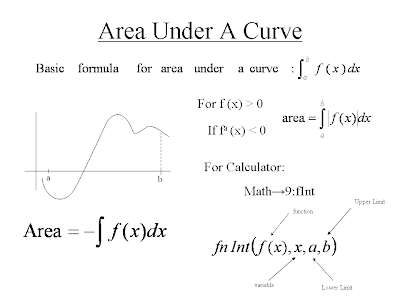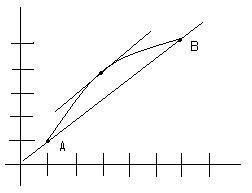




 For some practice problems, go to page 264 and do Exploration 1
For some practice problems, go to page 264 and do Exploration 1Homework: pg 254 #5-13 odd, 20; pg 267 #7-41 odd
This blog represents a compilation of the content, assignments, and other aspects of Mr. Marchetti's AP Calculus BC class for the 2007 - 2008 school year. This blog will be as useful and rich as you make it!





 For some practice problems, go to page 264 and do Exploration 1
For some practice problems, go to page 264 and do Exploration 1More generally, we can try to generate approximate solutions to the equation  using the same idea. Suppose that
using the same idea. Suppose that  is some point which we suspect is near a solution. We can form the linear approximation at
is some point which we suspect is near a solution. We can form the linear approximation at  and solve the linear equation instead.
and solve the linear equation instead.
That is, we will call the solution to  . In other words,
. In other words,

 was a good one, the approximate solution
was a good one, the approximate solution should be an even better approximation to the solution of
should be an even better approximation to the solution of  . Once we have
. Once we have  , we can repeat the process to obtain
, we can repeat the process to obtain  , the solution to the linear equation
, the solution to the linear equation

 , we generate
, we generate and so on. If, after n steps, we have an approximate solution
and so on. If, after n steps, we have an approximate solution , then the next step is
, then the next step is
 , this will produce approximate solutions to any degree of accuracy.
, this will produce approximate solutions to any degree of accuracy.



Implicit Differentiation
An example of a function that is explicitly defined would be y=f(x).
But unfortunately not all functions are explicitly defined, such as the equation of a circle x^2 + y^2 = r^2. This is an example of a function that is implicitly defined. Often with implicitly defined functions it is not possible to solve for y.
To equation of a circle can be divided into two pieces: the top half of the circle and the bottom half of the circle, with
each piece a separate function
The Implicit Differentiation Process
1. Differentiate both sides of the equation with respect to x
2. Collect the terms with dy/dx on one side of the equation
3. Factor out dy/dx
4. Solve for dy/dx
example 1:
x^3 + y^3 - 9xy = 0
The graph of x^3 + y^3 - 9xy = 0, a folium
-This function has well defined tangent lines at every point on the graph.
-Even though it is not a function in the classic sense, it is still differentiable
-The derivative from the right = the derivative from the left
x^3 + y^3 -9xy = 0
3x^2 + 3y^2 * dy/dx - 9x*dy/dx -9y = 0 Since y is a function of x, when taking the derivative of any term with y,
multiply by dy/dx
3y^2*dy/dx - 9x*dy/dx = 9y - 3x^2
y^2*dy/dx - 3x*dy/dx = 3y - x^2
dy/dx( y^2 - 3x ) = 3y -x^2
dy/dx = (3y - x^2)/(y^2 -3x)
*can use notation y' or dy/dx
example 2:
2y = x^2 + siny
2*y' = 2x + cosy*y'
2*y' - cosy*y' = 2x
y'( 2 - cosy) = 2x
y' = 2x / (2 - cosy)
Finding the tangent and normal lines to a curve:
-to find the slope of the tangent at a point, plug the coordinates of the point into the equation for dy/dx
example 1:
x^2 - xy + y^2 = 7 at ( -1,2 )
2x - x*dy/dx - y + 2y*dy/dx = 0
-x*dy/dx + 2y*dy/dx = y - 2x
dy/dx ( 2y-x ) = y -2x
dy/dx = ( y- 2x )/( 2y-x )
dy/dx(-1,2) = (2 - 2* -1)/(2*2 + 1) = 4/5
tangent: y-2 = 4/5(x+1)
normal: y-2 = -5/4(x+1)
*To find slope of normal line, use opposite inverse of slope of tangent line
In class, we took our first homework quiz over the derivatives thus far, with the exception of the exponential and logarithmic derivatives
Homework: page 155# 3-28, multiples of 3

Ok, I'm encoding this post in HTML so let me know if there are any problems. I figure I can use some coding to slightly alter the color of the math portions, therefore making them easier to read. Alright, so here we go:
Graph of Y' Stuff
Graphs are pretty important in Calculus as they form an easy allabi when you can't solve a problem. Anyways, there are alot of sweet things to know about a graph for example, if we take the function F(x)=X2 who's graph is
then you take the Derivative of the function, which happens to be Y' = 2X1 and you get this
Now you'll notice several things right away. First, is that the degree of the function is one lower. Second, you'll also notice, and the zero of the derivative is at the minimum of the original function. This can clearly be seen when you graph both of them at the same time
and zoomed in
Example Graphs
I figure I'll use a list instead of a table, the blog site probably won't respond to the coding. The function is in black, whilst the derivative is in red. The original function will come first, then both of then together.
Alright, even though Trigonometry is a total pain in the ass, we still have to do it. That being said, it's time consuming, stressful, and slightly annoying when you're attempting to find the F'(x) of a trig function. So, there are a couple tricks that make your life a whole lot easier when applied with the other calculus rules. On the left is a function, and on the right in green is the Y' of that function